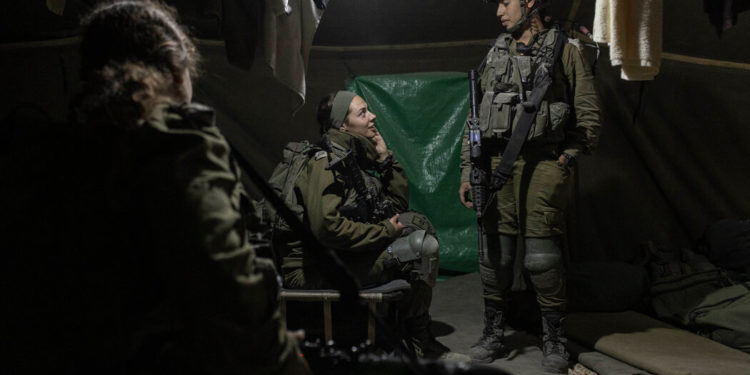By THE NEW YORK TIMES
When Capt. Amit Busi gets a chance to sleep, she does so with her boots on — and in a shared tent in an improvised Israeli military post in northern Gaza.
There she commands a company of 83 soldiers, nearly half of them men. It is one of several mixed-gender units fighting in Gaza, where female combat soldiers and officers are serving on the front line for the first time since the war surrounding the establishment of Israel in 1948.
Captain Busi is responsible not just for the lives of her subordinates — search-and-rescue engineers whose specialized training and tools help infantry troops enter damaged and booby-trapped buildings at risk of collapse — but also for the wounded soldiers they help evacuate from the battlefield. She and her soldiers also help scour the area for fighters, weapons and rocket launchers and are responsible for guarding the camp.
It can be easy to forget Captain Busi is only 23, given the respect she has clearly earned from her subordinates — among them Jews, Druze and Bedouin Muslim men.
“The borders have been blurred,” Captain Busi said of the decades-long limits on the roles of female combat troops in Israel. The military, she said, “needs us, so we are here.”
Since Israeli ground forces entered Gaza in late October, women have been there fighting. Their inclusion has helped bolster the image of the army domestically after the intelligence and military failures of Oct. 7, and amid global scrutiny of the campaign’s high civilian death toll. More than 23,000 Palestinians, many of them women and children, have been killed since the start of the war, according to Gaza health officials.
The integration of women into the military’s combat units has been the subject of a lengthy debate in Israel, home to one of the world’s few armies that conscript women at 18 for mandatory service. For years the question of women serving at the front pitted ultraconservative rabbis and religiously observant soldiers against feminists, secularists and critics of the country’s traditionally macho culture.
Now, that debate is effectively over.
There is no point continuing such arguments, Lt.-Gen. Herzi Halevi, the military’s chief of staff, said after female soldiers raced to confront Hamas attackers on Oct. 7, because their “action and fighting” speaks louder than words.
Like other fundamentals of Israeli life, many of the preconceptions about women in combat were upended on Oct. 7, when hundreds of Hamas-led gunmen surged across the border from Gaza into southern Israel, killing about 1,200 people, most of them civilians, according to Israeli officials, and abducting 240 captives to Gaza.
In the months since, the needs of the military has propelled societal change at breakneck speed. Same-sex partners of slain soldiers are now legally recognized widows and widowers, and at least one transgender soldier has fought on the front in Gaza.
Despite years of derision from conservative quarters of Israeli society, female combat soldiers have become symbols of progress and equality, appearing on magazine covers and featured in television news profiles.
A recent survey by the Israel Democracy Institute found that among the secular public, about 70 percent of women and 67 percent of men indicated support for increasing the number of women in combat roles.
In recent years, women have made up about 18 percent of the military’s combat force.
“Everyone is using the phrase ‘The debate is over,’” said Idit Shafran Gittleman, director of the Military and Society program at the Institute for National Security Studies at Tel Aviv University. “Everyone saw what happened on Oct. 7,” she said, adding that “women contribute to security, they don’t decrease security.”
Israeli women were thrust into combat almost immediately on Oct. 7. Two all-female tank crews, once the butt of sexist jokes, hurtled through the desert that morning to help repel waves of armed infiltrators from Gaza.
The female commander of Caracal, a mixed-gender infantry battalion, led a 12-hour battle along the Gaza border with two companies equipped with Lau missiles and machine guns. Together with the tanks, they helped block Hamas’s advance, saving several communities from attack.
“We stopped them, they didn’t pass us,” said the commander, Lt. Col. Or Ben Yehuda, 34, a career officer and a mother of three, speaking at the battalion’s desert base near the Egyptian border, where her unit is usually deployed.
Israel has had a female prime minister, Golda Meir from 1969 to 1974. The newly retired president of Israel’s Supreme Court, Esther Hayut, was among the country’s most influential officials, recently dealing an important blow to the efforts of the government of Prime Minister Benjamin Netanyahu to curb the powers of the judiciary.
Despite those accomplishments, the war has come at a low point for women’s representation in government, which is currently the most far-right in the country’s history. The war cabinet, assembled after Oct. 7, includes two former chiefs of staff and a general, but no women.
When female military lookouts sounded the alarm before Oct. 7 that they had spotted unusual activity along the Gaza border, which they assessed to be consistent with planning for a major terrorist attack, they say they were dismissed by their male senior officers, who suggested they were the eyes, not the brains, of the military.
Ultraconservative rabbis have disparaged women’s service in general and railed against Orthodox women, in particular, who waive religious exemptions in order to serve. And some conservative activists have discredited the success of female soldiers, asserting that women are held to easier standards and drag the army down.
Decades of Supreme Court petitions and rulings have challenged the military’s high command to balance operational needs with the principles of equal rights and equal opportunity.
The military has gradually opened up 90 percent of its roles to women but they are still excluded from frontline combat roles in the main infantry units and some of the most elite commando units that traditionally operate across enemy lines in wartime.
While some women serve in mixed-gender units, tank crews remain segregated by sex. That policy was meant to account for religious sensitivities about men and women being stuck together for days in a tank.
Yet women on the front say attitudes are changing.
“It’s a process,” said Capt. Pnina Shechtman, a platoon commander in a mixed-gender battalion, Bardelas, usually deployed along Israel’s southern border with Jordan. Captain Shechtman was speaking by phone after a day of operations inside Gaza.
“It’s a battlefield,” she said. “You see and hear and smell a lot. All of your senses are really sharp. I need to be focused; I have soldiers under me. There is no time for feelings.”
She said that she had commanded religiously observant soldiers and that it was all a matter of mutual respect. “At the end of the day,” she said, “we have the same mission.”
After sunset one recent weekday, a reporter and photographer for The New York Times rode into northern Gaza with Captain Busi and her comrades, stirring up dust clouds in a dark wasteland lit only by an almost-full moon.
Buildings along the route parallel to the Mediterranean shore were flattened into layers of concrete. We saw no people, only a few dogs, until we pulled into a small, barely lit army post of tents and containers surrounded by sand berms. Escorted by Captain Busi, we were free to roam the post but not go beyond it.
The Times accepted a military transport to secure rare access to wartime Gaza, which is typically off-limits to journalists. The Times did not allow the Israeli military to screen its coverage before publication.
Captain Busi, whose hair is woven in a long braid, carries up to a third of her body weight just walking around the base, between her ceramic bulletproof vest, M4 assault rifle and other equipment. Like everyone in the unit, she eats mostly rations of canned food, dried sausages and energy bars, and showers in a container about once every two weeks.
The first care packages that were delivered to the camp contained extra large T-shirts, boxer shorts and tzitzit, the ritual undergarments worn by Orthodox Jewish men. Now, they receive toiletries for women.
At the base in Gaza, flares lit up the sky. Nobody flinched at the occasional boom. Some of the male soldiers milling about said they slept well knowing that Captain Busi and her troops were guarding the base. One said he felt even safer with the women warriors because they had to prove themselves — not because they were women, but because it was their first time in Gaza.
The war has claimed the lives of about 200 Israeli soldiers and thousands of Palestinians, most of them civilians.
Captain Busi said the military “does everything” to try to avoid civilian casualties and lamented the destruction of so many homes. But it was Hamas, she said, that turned Gaza into a war zone.
The front line in Gaza is never more than a few hours’ drive from soldiers’ homes — a reminder of just how close the war is.
Captain Busi said she would stay in Gaza as long as she was needed.
“I really hope the fact that we are here,” she said, “means that 20 years from now, my children won’t have to be.”







Discussion about this post